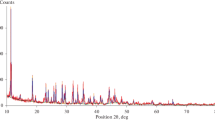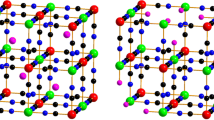Abstract
The thermal treatment of Fe2O3·1.65H2O gives rise to sharp dehydration weight-change waves (310–470 K and 470–670 K) which correspond to the loss of loosely-bound and stronglybound water, respectively. Analysis of the thermal waves was performed by the method of Šatava and Škvara (1969), the modified method of Coats and Redfern (1964) and the method of Blazejowski et al. (1983), and by applying a least squares straight line fit to the data. The A2 andA 3 decomposition mechanisms predominate in the first dehydration step, whereas anF 1 mechanism seems the best to describe dehydration of the structural water. Activation energies of 21 kJ · mol−1 and 95 kJ·mol−1 are estimated for the first and second steps, respectively.
Zusammenfassung
Bei der thermischen Behandlung von Fe2O3 · 1.65H2O werden zwei der Abgabe von schwach bzw. stark gebundenem Wasser zuzuschreibende Gewichtsveränderungen bei 310–470 K und 470–670 K festgestellt. Die Analyse der thermischen Kurven wurde nach der von Coats und Redfern (1964) und Blazejowski et al. (1983) modifizierten Methode von Šatava und Škvara (1969) ausgeführt und die Korrelation der Daten nach der Methode der kleinsten Fehlerquadrate berechnet. Die ZersetzungsmechanismenA 2 undA 3 dominieren im ersten Dehydratisierungsschritt, während die Abgabe von strukturellem Wasser am besten durch denF 1-Mechanismus zu beschreiben ist. Für den ersten und zweiten Schritt wurden Aktivierungsenergien von 21 bzw. 95 kJ·mol−1 ermittelt.
Резюме
Термическая обработ ка Fe2O3· 1,65H2O показала наличие двух резких п иков дегидратации при 310–470 К и 470–670 К, что соответству ет потери слабосвязанн ой и сильносвязанной вод ы. Анализ термических кривых проведен методом Шат авы и Шквары, а также видоизмененны ми методами Коутса-Рэ дферна и Бразейовски с сотр., с и спользованием метода наименьших кв адратов для подгонки кривой. На первой стадии разлож ения преобладающими явля ются механизмы разло жения А2 и А3, тогда как механизм F1 лучше всего описывает дегидрата цию структурной воды. Энергии активации, установле нные для первой и второй стадий, равнял ись, соответственно, 21 кдж·моль−1 и 96 кдж·мол ь−1.
Similar content being viewed by others
References
E. S. Freeman and B. Carroll, J. Phys. Chem., 62 (1958) 394.
C. D. Doyle, J. Appl. Polym. Sci., 5 (1961) 285.
V. Šatava, Silikaty (Prague) 5 (1961) 68.
H. H. Horowitz and G. Metzger, Anal. Chem., 35 (1963) 1464.
A. W. Coats and J. P. Redfern, Nature, 201 (1964) 68.
B. N. N. Achar, G. W. Brindley and J. H. Sharp, Proc. Int. Clay Conf., Jerusalem, 1 (1966) 67.
J. Šestak, Silikaty, 11 (1967) 153.
J. Zsakó, J. Phys. Chem., 72 (1968) 2406.
V. Šatava and F. Škvara, J. Am. Ceram. Soc., 52 (1969) 591.
J. R. MacCallum and J. Tanner, European Polym. J., 6 (1970) 1033.
V. Šatava, Thermochim. Acta, 2 (1971) 423.
J. Šestak and G. Berggren, Thermochim. Acta, 3 (1971) 1.
J. Zsakó, J. Thermal Anal., 5 (1973) 239.
J. Blazejowski, J. Szychinski and E. Kowalewska, Thermochim. Acta, 66 (1983) 197.
F. Martin, A. Gonzalez, J. Jimenez, J. Largo and J. A. de Saja, J. Thermal Anal., 29 (1984) 257.
J. P. Elder, Analytical Calorimetry, Ed. J. F. Johnson and P. S. Gill. Plenum Publishing Corp. 1984, p. 255.
B. R. Arora, N. K. Mandal, R. L. Chowdhury, N. G. Ganguli and S. P. Sen, Technology, 9 (1972) 143.
A. Spinzi and I. V. Nicolescu Rev. Romaine de Chim., 20 (1975) 387.
H. Tanaka and M. Tokumitsu, J. Thermal Anal., 29 (1984) 87.
A. M. Gadalla, Int. J. Chem. Kint., 16 (1984) 1471.
J. Blazejowski, Thermochim. Acta, 48 (1981) 109.
J. Zsakó and H. E. Arz, J. Thermal Anal., 6 (1974) 651.
Z. Adonyi and G. Körösi, Thermochim. Acta, 60 (1983) 23.
Author information
Authors and Affiliations
Rights and permissions
About this article
Cite this article
Petro, N.S., Girgis, B.S. Dehydration kinetics of hydrated iron oxide from dynamic thermogravimetry. Journal of Thermal Analysis 34, 37–45 (1988). https://doi.org/10.1007/BF01913368
Received:
Revised:
Issue Date:
DOI: https://doi.org/10.1007/BF01913368




